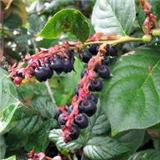I know, I know, another berry? Well, yes. Seeing as it is big time berry season, Gaultheria shallon just has to be recognized. You may not realize it, but this evergreen shrub dominates our forest floor. It is EVERYWHERE. But, not just in our backyards! From bio-regional restaurants, to the landscaping industry, to little old ladies who make jelly, to floral arrangements at your best friend's wedding, to First Nation families, and to sauvage enthusiasts, salal truly is a ubiquitous plant. So much, that a complete biography has been written about it, ("Salal: Listening for the Northwest Understory" by Canadian author and UBC professor Laurie Ricou).
There is so much to say about salal, but I will focus on its edible qualities and its importance in Coast culture. Now, I've got one word to say to you: fruit leather, baby! According to the forth mentioned book, the First Peoples of the West Coast invented it! During the months of August and September, Gaultheria shallon bears its fruit. Sweet, juicy and a little seedy, families collected enormous baskets worth, cleaned, mashed and cooked them with hot rocks,, then dried them in the sun or over fire. The cakes were stored over winter and brought out on special occasions.
Pretty neat. And (!) the leaves could also be made in to a poultice to treat burns and wounds, or made in to an infusion to treat indigestion, colic and tuberculosis. Today, those same families and other coastal residents preserve salalberries by making jam, jelly, syrup, jarring or freezing. While bushwhacking through the understory, identify these bad boys by their lovely green egg-shaped leaves and pinkish bell flowers (or berries, when in season) hanging from the branch tips. Check out the stems of the shrub and you will find that they are flexible and wiry. This helps in winter, letting it bear the weight of snow, letting it tower over the other plants. Usually, it is found in damp low-light places, but salal has adapted and can grow anywhere. The hight depends on conditions, sometimes ranging from knee high to 5-feet!
Caution; tics do reside in salal shrubs, so be aware of that. Do a tic check. But, don't let that deter you. The humble salal is of great significance and should be honored for its contribution to our West Coast landscape and history. I am happy to have been able to shine a light on this truly West Coast edible. Thanks!


